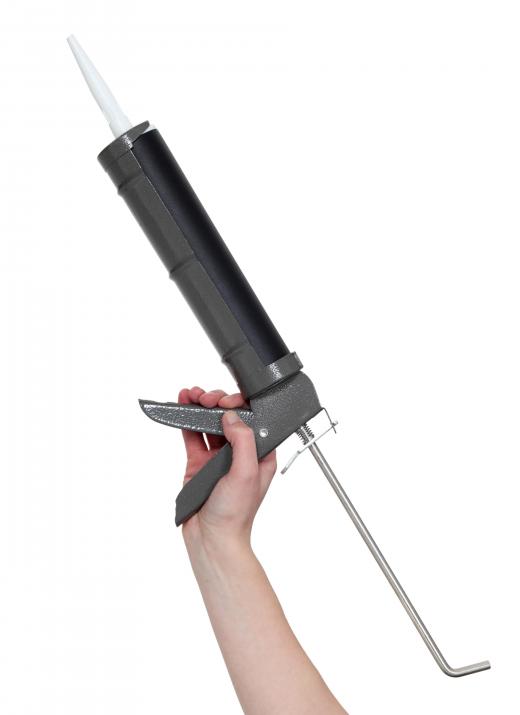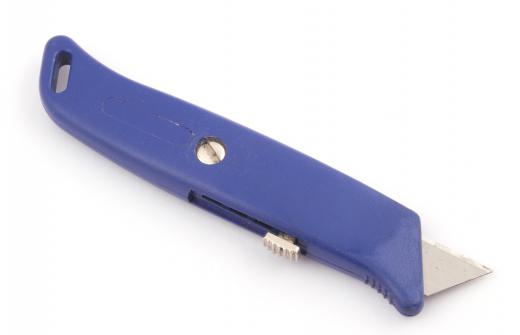How To Repair Small Cracks In Walls

Whether your walls are plaster, drywall, or physical, fixing pocket-size to medium cracks typically requires just a few tools and elementary instructions. Cracks result when a wall moves and are usually due to the house settling; the building materials in a house expand and contract due to temperature changes, and the soil under the firm can shift, both of which tin cause cracks. Most are cosmetic problems that you can repair using a putty or epoxy filler of some kind. Cracks that are especially wide or that show up once more, however, should be diagnosed and repaired by professional person contractors, as these may indicate serious structural damage.
Determine the Wall Type

The first step to repair cracks in walls is to determine what the croaky wall is made of. Whether yous are dealing with a concrete wall, a plaster wall, or drywall — also called sheetrock, plasterboard, or wallboard — affects the way you should go most fixing the crack. Mostly, merely older homes are finished with plaster, a gooey substance carefully spread onto closely-spaced, horizontal slatted boards called lathes. Drywall is ordinarily made of gypsum plaster sandwiched betwixt ii pieces of newspaper, and can exist found throughout a business firm; you will typically notice concrete walls in basements. One way that you may run into a divergence is that plaster and concrete ofttimes chip and crumble if you try to hammer a nail into them, only drywall usually will non.
Fixing Cracks in Plaster

A crevice in a plaster wall is oft the result of the plaster pulling away from the lathes. To ready the cleft, you will need to reattach the plaster to the underlying forest slats. This is usually done by injecting an agglutinative behind the plaster. To set up a crack in this kind of wall, you will need the following:
- plaster adhesive
- a drill with a masonry fleck
- a store vacuum
- liquid conditioner
- a caulking gun
- flat plaster rings with screws
- a putty pocketknife
- joint compound
- sandpaper
- primer and paint

The first step is to drill shallow holes on each side of the crack using a masonry scrap. Information technology is important to only drill through the plaster and not through the wooden slats underneath or the spaces betwixt them. If y'all practise drill betwixt slats, just mark those holes and exercise not fill them with adhesive. Once the holes have been drilled, clear away any dust using a vacuum. And so spray liquid conditioner — often packaged with the plaster adhesive — into the holes.

Fill the holes with adhesive using a caulking gun. Spiral the plastic plaster rings into the crack and through the lathes underneath to hold the plaster and lathe together tightly, and allow the adhesive to prepare overnight. The next day, remove the rings and scrape off whatsoever tags or high points using a putty pocketknife. Then employ a thin layer of joint chemical compound to fill up the cracks and any depressions. Let the compound to dry, and then sand, prime, and paint.

Superficial cracks in plaster walls tin can often be stock-still with spackling or articulation compound. After cleaning the dust from the crack, and putty knife can be used to fill it in with the chemical compound, existence certain to alloy the edges in with the surrounding wall. It can then be sanded, primed, and painted. While this method works for small cracks, it may not provide a long-term solution if the plaster is pulling away from the slats.
Fixing Cracks in Drywall
To repair cracks in walls made of drywall usually requires these tools:
- a utility knife
- a paintbrush or vacuum
- spackling compound or joint chemical compound
- a putty knife
- sandpaper and a sanding block
- primer and pigment
For large cracks, patching tape may be needed. If the drywall on 1 side of the crack feels loose, it may need to be secured to the underlying studs using a hammer and nails.

The first pace to repair cracks in walls made of drywall is to use a utility knife to widen the crack slightly. This gives the spackling or joint chemical compound a larger surface to attach to. Once yous take widened the crack, clean the grit and other debris out of the scissure using a paintbrush or vacuum.
Side by side, roughly fill the pigsty with compound, making sure to plume the edges beyond the cleft to produce a flat, even surface, and allow it to dry. Sand the area with a very fine-grit sandpaper rated for use with drywall. Using a sanding block or piece of bit wood under the sandpaper will make a flat surface and help yous avoid creating trenches or dips on the wall. If needed, apply a 2nd coat of compound, allow it to dry out, and sand once more. Once the surface is affluent with the balance of the wall, apply primer and paint.

To repair very wide cracks in walls, you may need a little more construction to make the repair stick properly. This is where patching tape, too called mesh tape or joint tape, comes in handy. Fill in the crack with compound, using strokes perpendicular to the crack. While the chemical compound is withal wet, cover the scissure with record, then use another thin layer of compound to help it to stick in place. Once the compound is dry, sand and finish the expanse.
Fixing Cracks in Concrete
Concrete walls are often repaired using an epoxy injection system, which has the benefit of keeping out wet, bugs, and other pests. You will as well demand the following:
- a wire brush
- a hammer and nails
- injection ports (commonly supplied with the epoxy)
- sealing paste (usually supplied with the epoxy)
- a putty knife
- a caulking gun
- a hacksaw
It is of import that the crack be dry out and free of debris before start. A wire brush works well to clear abroad clay, and a hair dryer can be used to dry the area.

First, align the epoxy injection ports; these are small plastic tubes that permit you to pump the epoxy inside the fissure later the surface is sealed. This is done by pounding thin nails partway into the crack spaced well-nigh 1 human foot (thirty.48 cm) apart, then slipping an injection port with a minor corporeality of epoxy on the back over the nail, which holds it in place. Cover the cleft with the sealing paste, creating a seal that will concur the the epoxy to be injected afterward. Brand sure the area around the port is covered completely, but don't block the opening. If the crack goes all the fashion through the wall, be certain to seal both sides.

Once the seal has cured — usually later a day or two — y'all can remove the nails. Use a caulking gun to inject the epoxy into the crack, starting at the everyman injection port. You volition know that you lot've injected enough epoxy when yous tin come across it begin to ooze from the port above. Plug the port and move to the one in a higher place it, injecting more than epoxy, until the entire fissure has been filled. The epoxy usually needs a few days to cure, after which you lot can apply a hacksaw to cut abroad the tops of the ports.
When to Call a Professional

If, after you repair cracks in walls, they reappear, become bigger, or are joined by cracks in other parts of the wall, ceiling, or foundation, it may exist a sign of a larger problem. The structural integrity of your house might exist compromised, then it's a good idea to consult a general contractor who can diagnose the crusade. He or she may detect that you crave extensive repairs to the frame or foundation of your domicile, which are best performed by professionals.
How To Repair Small Cracks In Walls,
Source: https://www.homequestionsanswered.com/how-do-i-repair-cracks-in-walls.htm
Posted by: mcraeopoetinat.blogspot.com


0 Response to "How To Repair Small Cracks In Walls"
Post a Comment